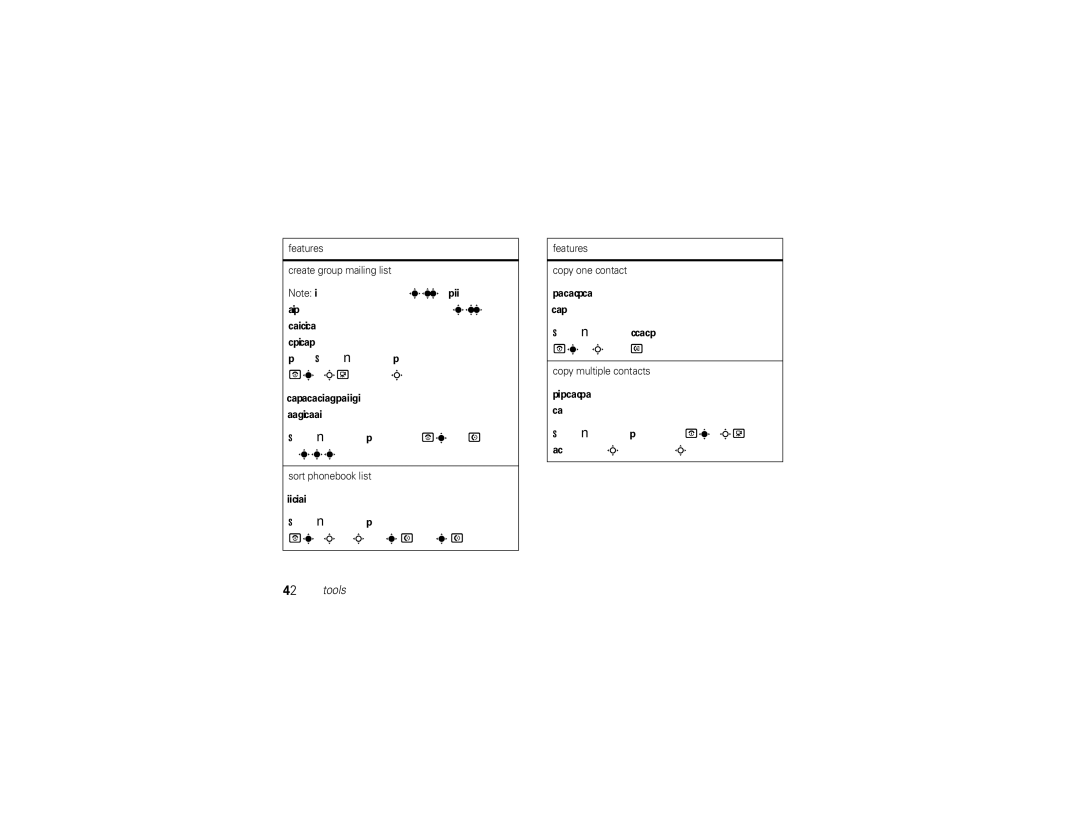MOTORAZR2TMV9x
Page
Hellomoto
See pictures Play music
Home Screen Main Menu
Contents
GPS & Agps
Menu map
Menu map
Main menu
Settings menu
In-Call Setup
For a basic phone diagram, see
Basics
Display
Basics
Signal Strength Indicator Vertical bars show
Active Line Indicator Shows h to
Volume
When a Java application is active
Ring Style Indicator Shows the ring style setting
Text message Voice message Voice & text message
To change your ringer volume when your phone is closed, see
Navigation key
Smart key
External display
Voice commands
Use voice commands
Voice commands
Set your ring style in the external display
Tips
Voice commands Send Message John Smith
Help Basics
Codes & passwords
Voice command setup
Lock & unlock phone
Lock your SIM card or applications
Security SIM PIN
To unlock it to answer
WSettings Security External Key Lock Timer a time
Lock & unlock external keys
Tips & tricks
Tips & tricks
Tips & tricks
Recent calls
Calls
Turn off a call alert
Return a call with your phone closed
Redial
Caller ID
Options Hide ID/Show ID Calls
Call
Emergency calls
Video calls
Make a video call
At the top of your display
To show the other caller your face and see
Record a video call
Your phone, above your external display see
Attach a phone number
Handsfree
Dialing options
Service dial
Set up quick dial
International calls
Fixed dial
Find it s w Settings Initial Setup Dtmf Long
Answer options
Call times & costs
Multi-Key
Hold a call
Mute a call
Call waiting
Conference call
Transfer a call
Restrict calls
Send or receive data
Phonebook entries
Entry modes
Text entry
Text entry
ITAP mode
ITAP and tap mode tips
Tap and tap extended modes
For example, if you press 7764, your Display shows
Numeric mode
Symbol mode
For example, if you press 7one time, your display Shows
Lowercase before the cursor moves to the next Position
Messages
Voicemail
Text messages
Send a text message
Use a message template
Receive a text message
Options and select Enter Number or Enter Email
Find it s e Messages Message Inbox
Read a message with your phone closed
To close the message display, hold the middle touch key
Print message over Bluetooth connection
Set up a blog account
Find it s e Messages, then press Options Setup
Blogs
Post to a blog
Find it s É Tools WebShare Blog Setup Blog Accounts
After you set up a blog account, you can post to it
Info services
Find it s e Messages Info Services
Browser messages
Find it s É Tools WebShare New Blog Message
Phonebook
Phonebook, then press Options Setup Speed Dial List Tools
Tools
Features Set ringer ID for a contact
Settings Ring Styles style Detail Ringer IDs Tools
Features Edit or delete a contact
Features Set picture ID for a contact
Features Set category for a contact
Phonebook, then press Options Filter by
Set picture ID view for phonebook
Options Setup Sort by First Name or Last Name
Options Select Multiple to Copy SIM to Phone
Phonebook, then press Options Create New Message List
Options Copy to SIM Card or Copy to Phone
Phonebook
Tools Alarm Clock
Personal organizer
Tools Calendar, then press Options Setup
Features See an alarm with your phone closed
Features See calendar event or task
Change calendar settings
Features Calendar event reminder
Tools Calendar
Multimedia Voice Record
Send calendar event to another device
Features Play voice record
Tools Calculator
Options Exchange Rate
Calculator
Bluetooth wireless
Find it s E Bluetooth Add Audio Device
Connections
Use a headset or handsfree car kit
Copy files to another device
Bluetooth power on, press s EBluetooth Setup
Send with Bluetooth for calendar events
If your phone could not copy the file to the other
Receive files from another device
Send files to a printer
Advanced Bluetooth features
Bluetooth Find Me
Bluetooth
Audio Devices
Options Manage Copy
Options Use Bluetooth to
Options Manage Move
Cable connections
Connect your memory card to a PC
On your computer
On your phone
USB Printing
Memory card files
If you have questions or need assistance, were here to help
Service & repairs
Service & repairs
Battery Use & Safety
Battery Use & Safety
Battery Charging
Specific Absorption Rate Ieee
Software Copyright Notice
Content Copyright
Software Copyright Notice
Performance Tips
Your Location
Emergency Calls
European Union Directives Conformance Statement
EU Conformance
Safety & General Information
Follow Instructions to Avoid Interference Problems
Safety Information
Product Operation
Symbol Key
Potentially Explosive Atmospheres
Glass Parts
Batteries & Chargers
Industry Canada Notice
Industry Canada Notice to Users
FCC Notice to Users
FCC Notice
Use & Care
Motorola Limited Warranty for the United States and Canada
Use & Care
Warranty
Products and Accessories
Exclusions Products and Accessories
Software
Exclusions Software
Hearing Aid Compatibility with Mobile Phones
Hearing Aids
WHO Information
Information from the World Health Organization
Product Registration
Export Law Assurances
Caring for the Environment by Recycling
California Perchlorate Label
Export Law
Privacy & Data Security
Privacy & Data Security
Driving Safety
Smart Practices While Driving
Driving Safety
Index
Index
Java indicator Keypad
Unlock application 15 phone 14, 15 SIM card
Voicemail message indicator Volume
To view the Quick Start Guide, go to

